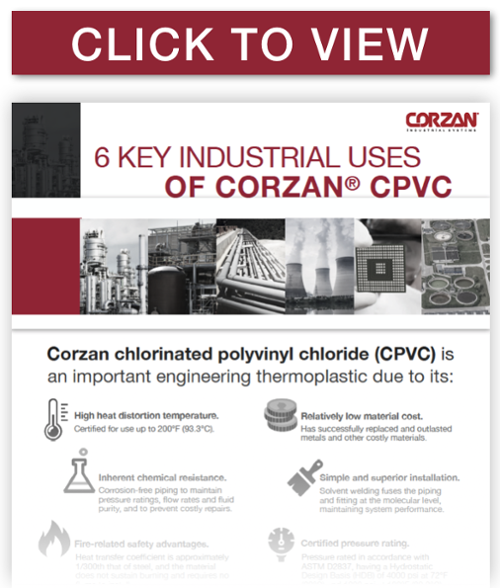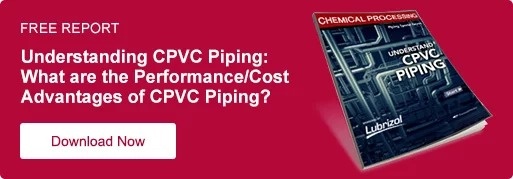6 Key Industrial Uses of Corzan CPVC [Infographic]
As the pioneer in chlorinated polyvinyl chloride (CPVC) technology, Corzan® Industrial Systems has proven its value and reliability for use in many types of industrial plants. To learn more about CPVC and its compatibility and uses across six demanding industrial applications, view our latest infographic.
If you prefer not to open the PDF infographic, read on for a text-only version.
Corzan® chlorinated polyvinyl chloride (CPVC) is an important engineering thermoplastic due to its:
- High heat distortion temperature. Certified for use up to 200°F (93.3°C).
- Relatively low material cost. Has successfully replaced and outlasted metals and other costly materials.
- Inherent chemical resistance. Corrosion-free piping to maintain pressure ratings, flow rates and fluid purity, and to prevent costly repairs.
- Simple and superior installation. Solvent welding fuses the piping and fitting at the molecular level, maintaining system performance.
- Fire-related safety advantages. Heat transfer coefficient is approximately 1/300th that of steel, and the material does not sustain burning and requires no flame to install.
- Certified pressure rating. Pressure rated in accordance with ASTM D2837, having a Hydrostatic Design Basis (HDB) of 4000 psi at 72°F (23°C) and 1000 psi at 180°F (82.2°C).
Learn more about CPVC by visiting our resource library, featuring ebooks, white papers, practical tools and more.
CPVC Is Often Used In the Following Six Industries
Chemical Processing
Reliably transport aggressive chemicals at high temperatures, under pressure, without corrosion concerns.
|
Compatible with:
|
Common uses:
|
Chlor Alkali
Transport harsh chemicals through some of the most corrosive environments imaginable with optimal service life.
|
Compatible with:
|
Common uses:
|
Mineral Processing
Resist abrasion and withstand other demands of precious and raw material processing operations.
|
Compatible with:
|
Common uses:
|
Power Generation
Stand up long-term to the high pressures and corrosive chemicals commonly used by power plants.
|
Compatible with:
|
Common uses:
|
Semiconductors
Meet the high purity standards for cleanrooms and eliminate corrosion concerns caused by aggressive chemicals.
|
Compatible with:
|
Common uses:
|
Wastewater Treatment
Put an end to corrosion, even when transporting the most aggressive disinfection chemicals.
|
Compatible with:
|
Common uses:
|
Learn More About CPVC
Our resource library features ebooks, white papers, practical tools and a blog updated by Corzan Industrial Systems’ product and engineering specialists.

